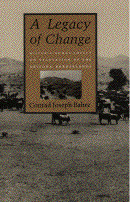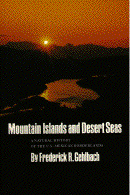 |
The Mexican Border Cities: Landscape Anatomy and Place Personality
by Daniel D. Arreola and James R. Curtis
Tucson: The University of Arizona Press, 1993.
This book examines the regional geography of18 Mexican towns and cities located along the U.S.-Mexican border and ranging in population from 10,000 to nearly a million. The authors demonstrate that, despite their close proximity to the United States, all these communities remain fundamentally Mexican in terms of their cultural landscape. The book includes chapters on urban structures, tourist and pariah landscapes, commercial landscapes, residential townscapes, and landscapes of industry and transit.
|

|
A Legacy of Change: Historic Human Impact on Vegetation of the Arizona Borderlands
by Conrad Joseph Bahre
Tucson: The University of Arizona Press, 1991.
Major vegetation changes have occurred in Southeastern Arizona since the arrival of Anglo settlers in the 1870s. While human land-use has long been acknowledged as an influence in some of these changes, it has also long been assumed that climate change was also a major influence in these changes. Bahre challenges this assumption of climate-induced vegetation change. By correlating his own field research with archival records and photos, he demonstrates that most of the major vegetation changes documented have occurred following some human disturbance. His work also provides new techniques for differentiating between human-caused and naturally occurring vegetation change.
|

|
Mountain Islands and Desert Seas:
A Natural History of
the U.S.-Mexican Borderlands
by Frederick R. Gehlbach
College Station: Texas A&M University Press, 1993.
This is a new edition of a work originally published in 1981. Written in an engaging and accessible style, the author considers the region within 100 miles of the International Border, from the mouth of the Rio Grande to the western edge of the Sonoran Desert. The entire book is informed by the author's view that (a) everything is connected to everything else, and (b) we can't begin to understand environmental conflicts, let alone resolve them, without a basic knowledge of natural history. |
|
|
Famine Early Warning and
Response: The Missing Link
by Margaret Buchanan-Smith and Susanna Davies
London: Intermediate Technology Publications, 1995.
Drought has caused several serious famines in Africa, and most of them were preceded by early warning signs. However, relief efforts are frequently "too little and too late" to be of real assistance to the target populations. Using case studies from Ethiopia, Sudan, Chad, Mali, and Kenya, this book examines how early warning information is used in decision-making, particularly within key donor agencies. Two major problems areas are identified: inability of the current relief system to respond quickly enough to prevent potential problems from becoming emergencies, and the complexity of government-donor relations, which tend to become mired in red tape and political maneuvering.
Functions of Nature: Evaluation of Nature in Environmental Planning,
Management and Decision Making
by Rudolf S. de Groot
Amsterdam: Wolters-Noordhoff, 1992.
This book provides a comprehensive method for systematic assessment and evaluation of all functions and values of natural and semi-natural ecosystems. Furthermore, it gives examples of how to use the concept of environmental function as a tool in environmental planning, management and decision-making. Of interest to managers of protected areas, planners, resource economists, environmental educators, and conservationists.
|
![]() No. 39, Spring/Summer 1996
No. 39, Spring/Summer 1996 



![]()